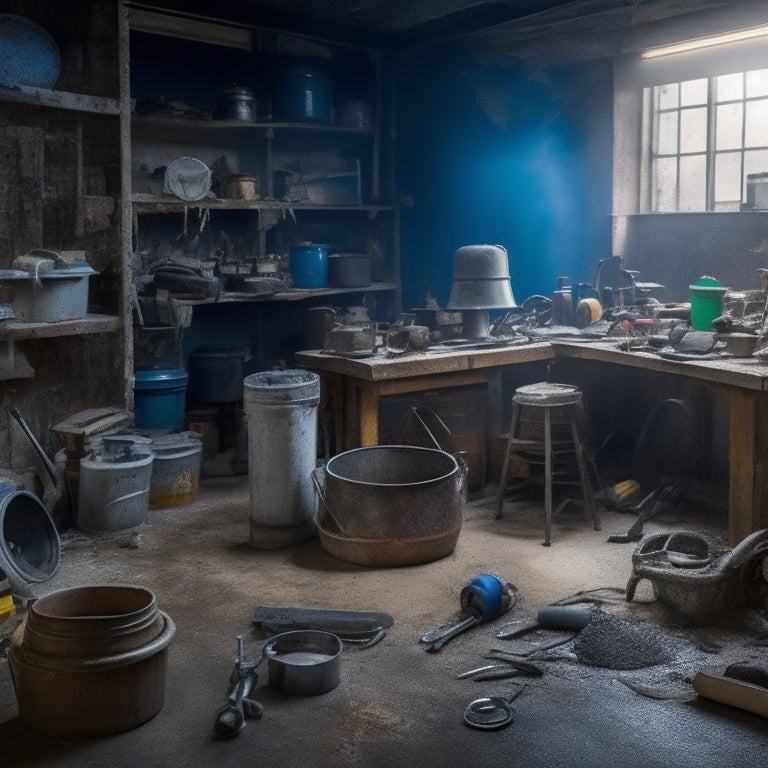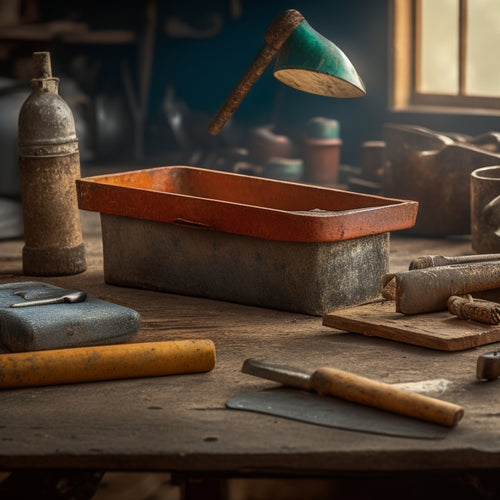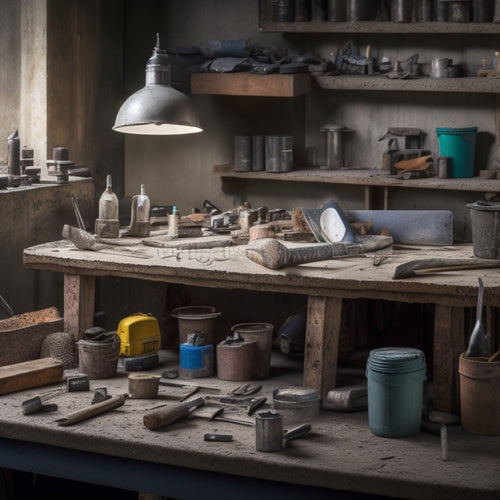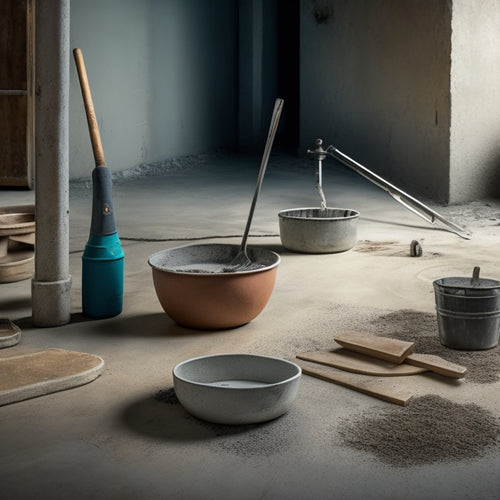
7 Tools to Fix Damaged Concrete Floors
Share
You're about to tackle that damaged concrete floor, and the right tools are essential for a successful repair. Start by removing old adhesive and paint, followed by grinding and polishing concrete edges for a smooth finish. Fill cracks with epoxy resin, then level and flatten the floor using self-leveling compounds. Apply concrete resurfacer coats, and finally, seal and protect the surface. Don't forget to address edges and corners with specialized repair kits. With these 7 tools in your arsenal, you'll be well on your way to restoring your concrete floor to its former glory, and there's more to discover about each step to guarantee a flawless finish.
Key Takeaways
• Remove old adhesive and paint using solvent-based removers, mechanical tools, and chemical paint strippers to ensure a strong bond with new material.
• Grind and polish concrete edges with diamond blades and polishing compounds to create a smooth surface for further repairs.
• Fill cracks with epoxy resin after thorough cleaning and proper mixing to ensure a strong bond with the concrete.
• Level and flatten the floor using self-leveling compounds and leveling tools to create an even surface for resurfacing.
• Seal and protect the surface with sealers and coatings to prevent water damage, stains, and wear, and enhance aesthetic appeal.
Remove Old Adhesive and Paint
Before you can repair a damaged concrete floor, you'll need to remove old adhesive and paint that may be obscuring the underlying surface. This vital step guarantees a strong bond between the new material and the concrete floor.
You'll need to employ effective adhesive removal techniques to break down and extract the old adhesive. One method is to use a solvent-based adhesive remover, applied to the surface and allowed to dwell before scraping off the adhesive. Another approach is to use a mechanical adhesive removal tool, which grinds away the adhesive layer by layer.
For paint stripping, you'll need to choose a method that suits the type of paint and its thickness. Chemical paint stripping methods involve applying a stripper to the paint, allowing it to break down, and then scraping off the paint. Alternatively, you can use a mechanical paint stripping method, such as sanding or grinding, to remove the paint layer by layer.
Regardless of the method, it's imperative to work carefully to avoid damaging the underlying concrete surface. By removing old adhesive and paint, you'll create a clean, even surface ready for repair and restoration.
Grind and Polish Concrete Edges
With the old adhesive and paint removed, you can now focus on grinding and polishing the concrete edges to achieve a smooth, uniform surface. This step is vital in preparing the floor for further repairs or finishing.
Start by using a concrete grinder with a diamond blade to remove any rough patches or imperfections. Apply gentle to moderate pressure, depending on the level of damage, and work in small sections to maintain control.
As you grind, use a vacuum or dustless grinding system to minimize dust and debris. Once you've ground the entire edge, switch to a polishing compound to further refine the surface.
Choose a compound suitable for concrete and follow the manufacturer's instructions for application and removal. You may need to repeat the polishing process several times, gradually increasing the grit level, to achieve the desired level of shine.
Remember to work methodically, using consistent grinding techniques and polishing compounds to guarantee a professional finish. By doing so, you'll create a strong foundation for the next steps in repairing your damaged concrete floor.
Fill Cracks With Epoxy Resin
When you're ready to fill cracks with epoxy resin, you'll need to start by preparing the surface to guarantee a strong bond.
Next, you'll mix the epoxy according to the manufacturer's instructions, taking care to get the ratio of resin to hardener just right.
Then, you'll apply the filler to the crack, using a tool or technique that suits the size and location of the damage.
Prepare the Surface
How thoroughly you fill cracks with epoxy resin will greatly impact the overall success of your concrete floor repair project.
To guarantee a strong bond between the epoxy and the concrete, you must prepare the surface properly. This involves thorough floor cleaning to remove dirt, oil, and other contaminants that might interfere with the epoxy's adhesion. Use a degreaser or a concrete cleaner to scrub the floor, and then rinse it thoroughly with clean water. Allow the floor to dry completely before proceeding.
Next, you'll need to remove any loose debris or crumbling concrete from the cracks. Use a wire brush or a scraper to clean out the cracks, making sure to wear protective gloves and eyewear.
Once you've cleaned out the cracks, vacuum or blow out any remaining dust or debris. This surface preparation is essential to guaranteeing a strong, long-lasting bond between the epoxy and the concrete.
Mix the Epoxy
You're now ready to mix the epoxy resin, a two-part compound that hardens when combined in a specific ratio, to fill the cracks in your concrete floor. There are various epoxy types, each suited for specific applications, so make certain to choose the right one for your project. For filling cracks, a 100% solids epoxy is ideal, as it provides excellent adhesion and durability.
When mixing epoxy, it's essential to follow the manufacturer's instructions and use the correct mixing techniques to guarantee a strong bond. Here are some general guidelines:
| Mixing Techniques | Tips |
|---|---|
| Mix in a well-ventilated area | Avoid inhaling epoxy fumes |
| Use a clean, dry mixing stick | Prevent contamination and guarantee thorough mixing |
| Mix in small batches | Prevent epoxy from hardening before application |
| Mix for the recommended time | Guarantee thorough blending of resin and hardener |
| Scrape the sides and bottom of the mixing container | Prevent unmixed material from affecting the bond |
Remember to mix the epoxy resin and hardener in the correct ratio, usually 1:1 or 2:1, and stir thoroughly until the mixture is uniform and free of streaks. Now that you've mixed the epoxy, you're ready to fill the cracks in your concrete floor.
Apply the Filler
With the epoxy mixture ready, pour it slowly into the prepared cracks, using a putty knife or pouring pot to fill them completely.
Make sure to fill the cracks slightly overfilled, as the epoxy will shrink slightly as it dries.
When applying the filler, consider the following techniques to achieve a successful repair:
-
Work in small sections: Divide the cracked area into smaller sections, and fill one section at a time to maintain control and avoid spreading the epoxy too thin.
-
Use the right filler type: Choose an epoxy resin specifically designed for concrete repair, and consider the color and consistency that best matches your floor.
-
Hold the putty knife at an angle: Hold the putty knife at a 45-degree angle to press the epoxy firmly into the crack, ensuring a strong bond between the filler and the concrete.
Level and Flatten the Floor
Before proceeding with repairs, assess the floor's surface to identify any high or low spots that need attention, as even slight deviations from level can compromise the integrity of the concrete.
Use a spirit level or laser level to detect any slope or unevenness, and mark the areas that require correction.
For minor slope corrections, you can use a self-leveling compound to fill in low spots. Apply the compound according to the manufacturer's instructions, and use a trowel or screed to spread it evenly.
For more significant corrections, you may need to use a leveling compound specifically designed for slope correction. These products are formulated to flow easily and self-level, making it easier to achieve a smooth, even surface.
Once you've applied the compound, allow it to set according to the instructions before moving on to the next step.
Remember to work in small sections to maintain control and guarantee a precise finish.
Apply Concrete Resurfacer Coats
Now that your floor is level and even, apply a concrete resurfacer coat to the entire surface, using a long-handled squeegee or trowel to spread it evenly and achieve a uniform thickness. This coat will help to fill in any imperfections and create a smooth surface.
When applying the resurfacer, make sure to use the right techniques to achieve the best results. Here are some tips to keep in mind:
-
Work in sections: Divide your floor into smaller sections, and complete each one at a time to maintain even coverage and prevent the resurfacer from drying out.
-
Use the right tool: Choose a squeegee or trowel that's suitable for the size of your floor and the type of resurfacer you're using.
-
Apply thin coats: Apply multiple thin coats, allowing each coat to dry completely before applying the next, to prevent the resurfacer from pooling or unevenly distributing.
Seal and Protect the Surface
Now that you've resurfaced your concrete floor, it's crucial to seal and protect the surface to guarantee its durability.
By doing so, you'll prevent water damage, enhance the aesthetic appeal, and reduce wear over time.
In this step, you'll apply a concrete sealer that will safeguard your floor against future damage and make it easier to maintain.
Prevent Water Damage
To prevent water damage, you should apply a concrete sealer or coating to protect the surface from moisture infiltration, as even small cracks can allow water to seep in and cause further deterioration. This is especially vital in high-traffic areas or zones exposed to harsh weather conditions.
By sealing the surface, you'll create a waterproofing barrier that prevents water from penetrating the concrete.
Here are three essential steps to achieve effective waterproofing:
-
Clean the surface: Verify the concrete floor is free from dirt, oil, and other substances that might affect the sealer's adhesion.
-
Choose the right sealer: Select a sealer suitable for your concrete type and environment. Acrylic, epoxy, and polyurethane-based sealers are popular options.
-
Apply the sealer correctly: Follow the manufacturer's instructions for application, and confirm the sealer is evenly distributed to achieve a uniform moisture barrier.
Enhance Aesthetic Appeal
Enhance Aesthetic Appeal
By applying a concrete sealer or coating, you can not only protect the surface from water damage but also enhance its aesthetic appeal, transforming a dull, worn-out floor into a vibrant, attractive space. This is where decorative overlays and color staining come into play. These tools allow you to customize the appearance of your concrete floor, adding a touch of elegance and sophistication.
| Technique | Description |
|---|---|
| Color Staining | Adds a rich, vibrant color to the concrete surface, creating a unique and eye-catching design. |
| Decorative Overlays | Applies a thin layer of decorative material over the existing concrete, providing a fresh, updated look. |
| Acid Staining | Uses acid-based chemicals to create a mottled, marbled effect, adding depth and character to the floor. |
| Dye Staining | Utilizes dye-based chemicals to achieve a consistent, uniform color, ideal for creating a subtle, understated appearance. |
| Epoxy Coating | Applies a durable, glossy epoxy coating, providing a high-gloss finish and exceptional durability. |
Reduce Wear
Frequently, concrete floors require a protective barrier to shield them from wear and tear, and applying a concrete sealer or coating is an effective way to achieve this. By doing so, you'll not only reduce wear but also make surface maintenance a breeze. Wear resistant coatings, in particular, are designed to withstand heavy foot traffic, chemical spills, and other forms of abuse.
Here are three key benefits of sealing and protecting your concrete floor:
-
Improved durability: A sealed floor can last longer and resist damage from wear and tear.
-
Easy maintenance: Sealed floors are easier to clean and maintain, saving you time and effort.
-
Enhanced appearance: A protected floor can retain its original appearance, ensuring your concrete floor looks its best for years to come.
Edge and Corner Repair Kit
How do you tackle damaged edges and corners that are crumbling, cracked, or broken, compromising the structural integrity of your concrete floor?
That's where an Edge and Corner Repair Kit comes in. This all-encompassing kit is designed to provide you with the necessary tools and materials to restore damaged edges and corners to their original state.
The kit typically includes a specialized epoxy-based adhesive, a polymer-modified concrete patching compound, and a set of precision tools for application and finishing.
With these components, you can employ advanced edge repair techniques, such as injecting epoxy into cracks or creating a new edge profile using the patching compound.
Corner restoration methods, like rebuilding damaged corners with the patching compound or reinforcing them with fiber mesh, are also made possible with this kit.
Frequently Asked Questions
Can I Fix Damaged Concrete Floors Myself or Hire a Professional?
When dealing with damaged concrete, you're faced with an important decision: should you tackle the repair yourself or bring in a pro?
If you're comfortable with DIY techniques and have experience with concrete work, you might be able to handle minor repairs.
However, if the damage is extensive or you're unsure about the underlying cause, it's often better to hire professional services to guarantee a long-lasting, high-quality fix.
How Long Does It Take to Complete a Concrete Floor Repair Project?
Like a puzzle, a concrete floor repair project requires careful planning and execution.
You'll need to factor in the repair duration, which can range from a few days to several weeks, depending on the severity of the damage.
A typical project timeline includes preparation, repair, and curing time.
Be prepared to allocate 2-5 days for small repairs, while larger projects can take 2-6 weeks.
Plan accordingly to guarantee a successful and durable repair.
Are There Any Safety Precautions I Should Take During the Repair Process?
When tackling a concrete repair project, you'll need to prioritize safety above all else.
Make certain you're equipped with the right personal protective gear, including gloves, safety glasses, and a dust mask.
Always inspect your repair equipment before use, making sure it's in good working condition.
Additionally, take steps to control dust and debris, and keep the work area well-ventilated to avoid inhaling harmful particles.
Can I Fix Concrete Floors That Have Been Damaged by Water or Flooding?
As you wade through the aftermath of a flood, the once-sturdy concrete floor now resembles a war-torn battlefield.
But fear not, you can resuscitate it from the brink of destruction.
Yes, you can fix concrete floors damaged by water or flooding.
How Much Does It Cost to Fix a Damaged Concrete Floor on Average?
When you're dealing with a damaged concrete floor, you're probably wondering how much it'll cost to fix it.
On average, repair costs can range from $2 to $15 per square foot, depending on the extent of the damage.
For concrete restoration, you might need to budget for materials like epoxy, polyurethane, or specialized coatings.
These costs add up quickly, so it's crucial to get an accurate assessment of the damage before starting the repair process to guarantee you're prepared for the financial investment.
Conclusion
You've tackled the toughest tasks and transformed your damaged concrete floor into a stunning surface.
Now, take a step back and admire your handiwork! With these 7 tools, you've erased old imperfections, smoothed out rough edges, and applied a fresh coat of protection.
Your floor's makeover is complete, and it's ready to withstand the wear and tear of daily life.
Pat yourself on the back – you've earned it!
Related Posts
-

Smart Guide to Buying Used Concrete Hand Tools
You're about to buy used concrete hand tools, and you need to get it right. Dedicate time to identify the tools you n...
-

Top Tools for Concrete Repair Success
When it comes to concrete repair success, you'll need a well-stocked toolkit with essential hand tools like trowels, ...
-

Why You Need These Concrete Overlay Tools
When tackling a concrete overlay project, you need the right tools to achieve a flawless finish and avoid costly mist...


